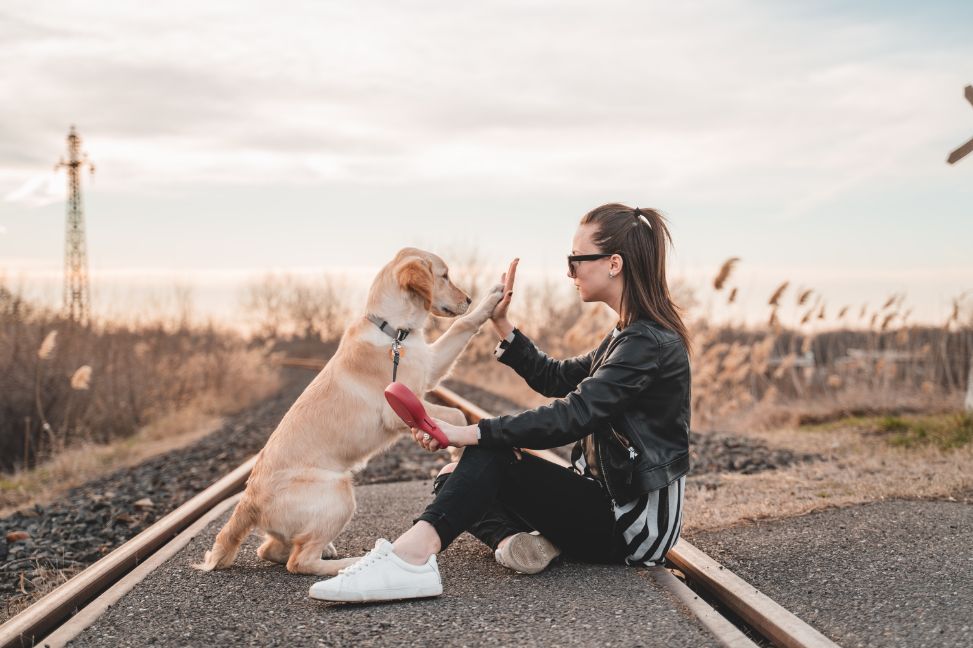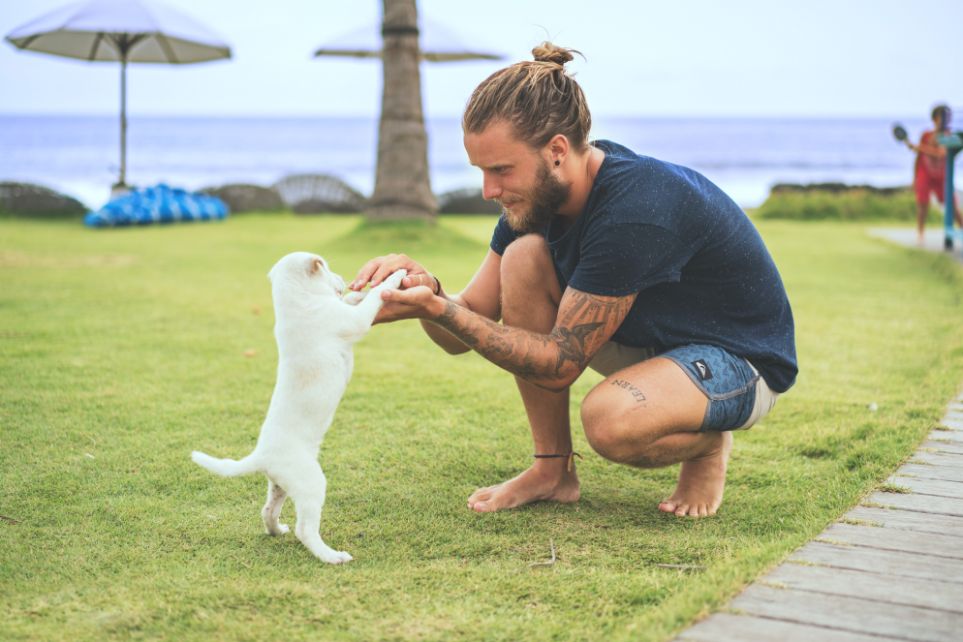Dogs can be very labor-intensive to train, especially when you first begin, between potty training, teaching them tricks, and teaching them fundamental commands (like sit or stay). And if you’re a new puppy owner, you might be wondering when to start training your puppy or how long it takes.
When estimating how long it might take to train a dog, a number of factors come into play. Are you focusing on overcoming a behavior issue or teaching fundamental skills? What educational background does the dog have? Have they ever undergone training that involved punishment or other aversive methods? Do they represent adults who lack any formal education? This article will tell you.
Further Reading:
- How To Leash Train A Puppy?
- Puppy Crate Training Schedule: Full Guide
- Potty Training Your Puppy In An Apartment: 10 Tips To Remember
- How To Bell Train A Puppy To Go Outside?
How Long Does It Take To Train A Puppy?
The short answer is that it depends; it could take a few weeks or a few months. For instance, some puppies may be fully housetrained in six months while others may continue to have recurring accidents. The speed at which puppies pick up commands varies.
“Expect it to take several months to go from the basics of teaching them to focus on you and work for rewards to sitting and laying down, eventually working up to ‘stay’ and ‘come,'” says Veterinary specialist Jessica Romine, of Detroit’s BluePearl Specialty and Emergency Pet Hospital
“It is much simpler to lay a strong foundation during the first six months because the majority of behavioral patterns are established by then.” She also cautions pet parents to “go slow and steady” with training, as “overwhelming a dog can have significant negative effects.”
It’s crucial to note that training is a continuous process and shouldn’t end at a certain age, says Dr. Ferris says. “I advise pet owners to regularly incorporate training methods into their daily routines.”
Training A Puppy Covers More Than You May Think
Training a puppy includes teaching them to use the restroom outside, behave well inside, get along with people, and learn commands.
In accordance with predetermined timelines, they can learn various training techniques. For instance, it takes most puppies between four and six months to only learn to use the bathroom outside.
Do keep in mind that even young puppies can learn negative behaviors that need to be corrected. If they were born somewhere else—outside or in someone else’s home—you might not be starting from scratch, and training might take longer or be harder.
It will take your puppy their entire puppyhood, three years, and will need to be maintained for the rest of their lives to training them to be happy, well-adjusted dog that gets along with people. You can’t just tell someone how to do something and then expect them to always follow your example.
Dog Training Timeline: Tips For Success
Get Everyone In The House On Board

To successfully address behavioral issues in particular and to teach new skills, it is essential to get everyone in the family on the same page. The human members of the family must agree to turn around, exit through a doorway, or walk away if the dog jumps on them, for example, if we are trying to teach a dog that jumping on humans does not reward a dog with the attention they seek.
If everyone is on board, the dog will eventually realize they can jump “until the cows come home,” but unless they alter their attention-seeking tactics, they will never succeed in getting the attention they crave. As long as more polite requests are being rewarded, jumping will eventually die out (disappear) and be replaced by more polite requests.
If one family member decides to shower the dog with praise whenever they jump up, the dog learns that the tactic occasionally works and has no reason to switch to something more polite.
Consistency Over Time Is Key
The household as a whole must support the training techniques, and they must be consistently applied over time. Consider self-serving actions like jumping up to attract attention as your dog plays the love-slot machine.
Fido jumps up four out of five times, and you don’t pay attention until he offers a more courteous alternative (i.e., standing calmly with four paws on the floor or sitting at your feet). However, when your dog jumps for the fifth time, you remember or are otherwise preoccupied and pay attention to them.
You might be willing to play a few games and try your luck if the chances of winning at a slot machine were one in five.
This calculation is also performed by your dog. Try it first before asking for attention in a more polite manner if the enjoyable, natural behavior is rewarded one out of every five times.
It’s Harder To Build A Good Habit From Scratch Than Change A Bad Habit
Have you ever tried to get rid of a bad habit you have? Suppose you smoke or bite your nails. If you have, you are aware that introducing something completely new into your routine is much harder than breaking a habit that has been practiced hundreds, thousands, or even more times.
For our dogs, the same idea applies. It is always more efficient to teach a new skill than to try to change how your dog currently interacts with a certain thing, activity, or person.
Behaviors Rooted In Emotions Take Time To Change
Depending on the particular dog, it won’t take much work to teach them a basic skill like sit or down. Contrarily, it takes time and effort to train people to improve their fear- or anxiety-based behaviors. When we employ traditional conditioning methods like desensitization and counterconditioning, we are attempting to address a deep-seated issue in your dog’s brain.
Try to overcome your own fear of spiders, heights, small spaces, or anything else that makes you uncomfortable. Would one therapy session alter the way you react to these triggers? How about ten sessions? There’s no way to know how many sessions there will be.
Teaching your dog to trust you and giving them the space they require to deal with their anxiety are the only ways to determine how quickly, if at all, the fear will improve.
You Can Only Train Your Dog As Quickly As They Can Learn
Different dogs pick things up at different rates. Young, malleable dogs frequently pick things up quickly, as do working breeds, but ultimately, it comes down to the individual, not maturity or genetics. Breed type and age can occasionally be a factor.
If you can introduce new skills to your dog in calm, familiar settings free of distractions, such as inside the home, your dog is likely to learn them more quickly. Your dog might have trouble understanding certain cues or learning in general, even under ideal circumstances. (See below).
Assuring that you are communicating clearly and moving at a pace that your dog can handle is important because the quality of the teacher is frequently a factor in how easily a student learns.

Dogs With A History Of Aversive Training May Have Trouble Learning
Alpha rolling, the use of prong collars, and other aversive training methods that intimidate or hurt dogs can instill a lifelong fear of learning in them. These dogs have a history of training, and they are frequently simple to spot.
They might not want to follow lures because they are worried about the consequences if they do. Marker words or clickers may startle them because they used to associate loud noises with punishment. During training sessions, they might become too tense or unable to concentrate due to anxiety.
These dogs need extra consideration and patience during training in order to help them get over their fear of learning.
High-quality Rewards = High-quality Learning
The more desirable the rewards you give your dog during training, the more eagerly they will take in new information. Try high-value treats like tiny pieces of hot dog, chicken, or cheese for faster reactions instead of kibble and packaged treats, though kibble and packaged treats are acceptable (although they might not have enough impact in some situations to work at all).
You’re Never Really Done Training A Dog
Dogs never really stop learning, just like people do. Therefore, even after you’ve taught them a deadly recall and a bombproof down-stay, their training isn’t finished. Your dog will closely observe you for cues on how to navigate their world for the duration of your relationship.
What Advantages Do Consistent Training Programs Offer?
Exercises for training are a great way to strengthen your relationship with your dog and increase his self-assurance. It’s also a fantastic way to help your puppy feel at ease with grooming and going to the vet, says Dr. For instance, if you touch different parts of their bodies with your hands or pick up one paw at a time, it will help puppies become accustomed to being handled, says Ferris.
“The more you make it fun, engaging, and comfortable for them by playing with their mouth, ears, and feet at a young age, making it a very positive experience, the easier time they will have with grooming and going to the veterinarian later on in life,” she says.
Conclusions
In general, including training in your daily routine will help keep your dog’s skills up to date and teach them how to respond to various situations. Your dog won’t abandon the behaviors you’ve taught them if you continue to reinforce them over time with frequent or even infrequent rewards.





